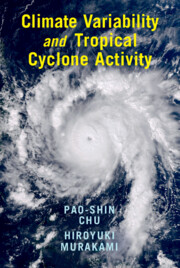Book contents
- Climate Variability and Tropical Cyclone Activity
- Climate Variability and Tropical Cyclone Activity
- Copyright page
- Contents
- Preface
- Abbreviations
- 1 Introduction
- 2 Climate Variability. Part I: Intraseasonal Oscillation
- 3 Climate Variability. Part II: Interannual to Interdecadal Variability
- 4 Climate Variability and Tropical Cyclones
- 5 Subseasonal to Seasonal Tropical Cyclone Prediction
- 6 Extreme Typhoon Rainfall Under Changing Climate
- 7 Future Tropical Cyclone Projections and Uncertainty Estimates
- Index
- References
3 - Climate Variability. Part II: Interannual to Interdecadal Variability
Published online by Cambridge University Press: 17 February 2022
- Climate Variability and Tropical Cyclone Activity
- Climate Variability and Tropical Cyclone Activity
- Copyright page
- Contents
- Preface
- Abbreviations
- 1 Introduction
- 2 Climate Variability. Part I: Intraseasonal Oscillation
- 3 Climate Variability. Part II: Interannual to Interdecadal Variability
- 4 Climate Variability and Tropical Cyclones
- 5 Subseasonal to Seasonal Tropical Cyclone Prediction
- 6 Extreme Typhoon Rainfall Under Changing Climate
- 7 Future Tropical Cyclone Projections and Uncertainty Estimates
- Index
- References
Summary
It is well known that the El Niño–Southern Oscillation (ENSO) is the most prominent mode of interannual climate variability in the tropics. The ENSO is a coupled, tropical ocean–atmosphere system that fluctuates on a time scale of two to seven years in the Pacific (Philander, 1990). The ENSO extremes are labeled as either a warm or cold phase, yet its amplitude varies across a continuum with essentially Gaussian statistics (Trenberth, 1997). Characterizing the warm (cold) ENSO phase is the presence of the anomalously warm (cold) sea surface temperatures (SSTs) in the eastern and/or central equatorial Pacific known as the El Niño (La Niña) event.
- Type
- Chapter
- Information
- Climate Variability and Tropical Cyclone Activity , pp. 42 - 98Publisher: Cambridge University PressPrint publication year: 2022



